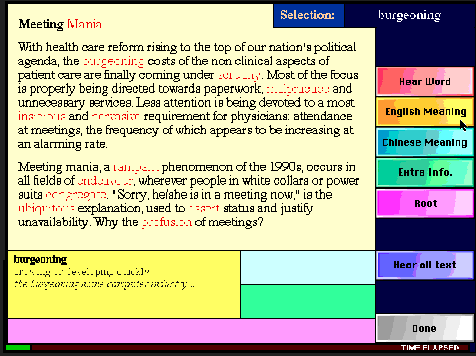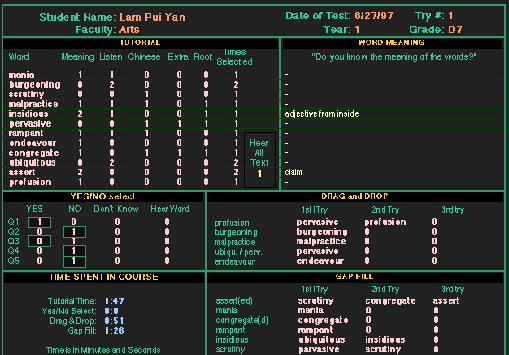Words in Your Ear: English vocabulary learning program
Monica HillEnglish Centre
University of Hong Kong

Words in Your Ear: English vocabulary learning programMonica HillEnglish Centre University of Hong Kong |  |
This multimedia program focuses on short texts which contain highlighted low frequency words and students are encouraged to select the information they require to help them better understand and remember the target words: English dictionary meaning and use in a different context; Chinese translation; digitised recording of the pronunciation of the word; its root and additional syntactic information.The self learning tutorial is followed by exercises to assess the learners' ability to reproduce the words and feedback is provided for incorrect responses. The teacher can access a list of all participants and view the results of any session.
A key feature of this project is that, in addition to using multimedia as an educational tool, extensive tracking of the participant's key strokes provides feedback to both the student and teacher on the effectiveness of this method of autonomous learning. The structure of the program also allows for further development so that students from any department within the university will be able to access examples of texts from their discipline and obtain lexical information on unfamiliar items to facilitate their comprehension of the word or concept. Future programs will incorporate graphic representations of words and short video clips to enhance comprehension of word meanings.
'A Word in Your Ear' has a dual purpose: it is primarily a teaching tool for Chinese tertiary learners who wish to develop their English vocabulary while it allows learners to select the information they require to help them learn unfamiliar words in context. Secondly, it is a research tool to establish which dictionary look-up procedures are most effective.
A carefully selected text of about 120 words is displayed on the screen with twelve unfamiliar words highlighted. All the other words in the text are familiar to the learners. By selecting each highlighted word, the subjects are able to choose the information they feel is most useful to help them learn unfamiliar words in a text. As a research tool, the computer is programed to track every mouse click, thereby noting in a separate log each item of information selected by the learners.
Following the text based study phase, or tutorial session, three sets of exercises are included to assess the subjects' knowledge of the highlighted words in the text. The data collected in the log are analysed together with the subjects' responses to the exercises.
One of the first L2 vocabulary researchers to incorporate commercially produced CALL materials in his studies was Palmberg. An early experiment studied the effects of children's interaction with computers on their learning of foreign vocabulary. He reported on the progress made by two Swedish speaking boys learning English in Finland using a game 'Pirate Cove' designed for L1 children and found that the boys were highly motivated during the lesson. They learned 'in only two 45 minute lessons to recognise and interpret correctly the major part of the vocabulary used in the game' (Palmberg, 1988, p 251). While youngsters may find computer programs motivating, it is questionable whether this tendency will continue through adolescence to undergraduate students.
Knight's (1994) study describes two groups of adult intermediate level students of Spanish who are required to read short texts presented in Spanish on a computer screen. One group had access to a computer based dictionary while the other group were encouraged to guess the meanings of unknown words from context. The computer kept track of the dictionary use counts of all the words checked as well as the length of time each student spent reading the article. The results suggest that students who use a dictionary learn more words than those who do not and they also achieved higher reading comprehension scores. Considerable incidental vocabulary learning was noted in the group which had no dictionary access. However, it is arguable whether these findings apply to all levels of verbal ability and, in addition, the length of time spent reading the texts varied.
In a related study, Hulstijn (1993) presented a computer based text to two groups of Dutch students learning English. Subjects were able to access the L1 translation of unknown words from the built- in dictionary and the computer tracked the frequency of look ups. This study, however, focused on the influence of task and learner variables. Hulstijn found that words which were deemed relevant for the task were looked up more frequently than those which were considered irrelevant and that words whose meanings could be guessed from context were looked up less frequently than those whose meanings could not be easily inferred.
Leffa (1992) conducted a study on a group of twenty first year university students to see whether a computer mediated electronic glossary, or computer dictionary, was more or less effective than a traditional bilingual dictionary when used with a translation task. The findings showed that the computer dictionary was more efficient, allowing the subjects to 'understand 38% more of the passage, using 50% less time' (p 63). The task involved translating a passage from English into Portuguese and Leffa concedes that 'the glossary capitalised on the great number of cognates that occur between English and Latin languages'(p 73). Leffa suggests that in traditional dictionary usage, the learner loses the context of the passage during the time it takes to locate the dictionary entry. With a computer dictionary the speed of access allows the context to remain in the short term memory, thus accelerating the comprehension process.
A more recent experiment by Svenconis and Kerst (1995) involved the use of hypertext and sound links. Hypertext allows non-sequential movement within a computer program. Links are provided between objects and words on the screen and multiple pathways provide readers with the choice of presentation sequence. For example, a hypertext link to a word may allow the reader to select its meaning, translation, relationship to other words or sound. This experiment involved semantic mapping and the subjects were required to link words together according to their meaning. The subjects, 48 American high school children who had never learned Spanish, were given 22 minutes to review each of three groups of Spanish words. One of the research questions focused on whether or not the sounding of a vocabulary item improved its retention and recall. The results showed that there was a significant univariate effect and scores rose for 'sounded' conditions and fell for 'unsounded' conditions.
Clarke's (1993) paper on multimedia and the design of lexical databases provided a considerable number of practical suggestions in the development of 'A Word in your Ear'. He emphasizes the importance of a voice card as 'there is evidence that phonological contours may form one parameter in mental lexical storage. Thus sound representation of lexical items is desirable, even for readers and writers' (p 11).
These studies are relevant for the design of this computer based program which incorporates several of their key features. It should, however, be remembered that there is a much greater proximity between English and the European languages used in the above studies than exists between English and Chinese. One problem, which is rarely referred to in the literature, is the amount of time involved in constructing a computer program and the number of 'glitches' that have to be ironed out in beta tests before the experiments can be carried out. It is also possible that the subjects referred to in western contexts may be more computer-literate than some of the Hong Kong subjects who appear only to be familiar with computer games.
| mania | burgeoning | scrutiny | malpractice |
| insidious | pervasive | rampant | endeavour |
| congregate | ubiquitous | assert | profusion |
Laufer (1988) recommends 95% as the minimum lexical density for reading comprehension at tertiary level, that is, students need to understand 95% of a text's lexis in order to reach a reasonable level of comprehension of the text's content. Given that this exercise is part of a vocabulary enhancement program it is suggested that the preferred new word density might be 1:15, i.e. the understanding of 80% word tokens in a text. It is anticipated that this ratio of familiar to unfamiliar lexical items will be sufficiently challenging to encourage learners to use the additional lexical information incorporated into the program, without the task becoming overwhelming.

Figure 1: Opening screen
The pre test follows and learners are asked to type in the meaning of any words they know. This draws their attention to the target words which they will be learning in the tutorial and allows the teacher to find out whether or not the words are familiar.
The screen displays the text 'Meeting Mania' in which the twelve target words are highlighted in red (as opposed to black). Subjects are instructed to select unfamiliar words by clicking on them with the mouse and then choosing the information they need to help them better learn the word. Optional information is provided in the form of L1 meaning in Chinese characters, L2 dictionary definition, pronunciation in the form of a digitized voice recording (aiff file), root and 'extra information' such as adjectival or verbal forms. Figure 2 shows the screen print out of the tutorial phase with the word 'burgeoning' selected and its English meaning. The dictionary definitions and contextualised examples are taken from the Longman Dictionary of Contemporary English. The examples are recycled at a later stage in the program when subjects are given a cloze test with target words omitted.

Figure 2: Screen print out of text based tutorial
The line along the bottom of the screen keeps track of the amount of time spent in this learning phase. Ten minutes is generally found to be adequate. The Chinese translations were kindly provided by Chinese speaking colleagues and then the characters were scanned into the program.
In addition to the phonemic transcription of the target item, other forms of the word are provided together with details of levels of formality, prepositions which follow the item, related meanings and other semantic and syntactic details.
The root of each target word was taken from Chambers Etymological dictionary and incorporated into the program to ascertain whether or not Chinese tertiary learners focus on the morphology of unfamiliar lexical items as a learning tool.
On completion of the tutorial phase, subjects select the button entitled 'Done' and are told how long they spent in the tutorial phase. They are then invited to complete three short tests to assess their knowledge of the target words. The tests are designed to ascertain how much attention has been paid to learning the words in the tutorial phase.
At the end of each exercise, subjects can opt to continue, quit or return to the tutorial for further input. The first test aims to measure the subjects' familiarity with the target lexical items. If the subject answers correctly, she can continue to the next question. If she answers incorrectly, or if she clicks the 'Don't know' button, feed back is provided in the form of the English meaning of these two target words. Subjects are also able to hear the word pronounced again if they wish.
The second test involves matching a target item with a given meaning. In this test, six target items have to be matched with English meanings. Subjects are required to use the mouse to 'drag' a target word and 'drop' it into a box if it matches the meaning shown on screen. If the answer is correct, she can proceed immediately to the next question. If the answer is incorrect, for example she drags 'endeavour' to the box instead of 'profusion', feedback is provided in the form of the definition and contextualised example of the inappropriate response.
The final test is a cloze exercise in which subjects are asked to complete the gap with one of the twelve target words. The degree of task difficulty increases with each exercise. In the comprehension exercise, receptive knowledge is tested, then controlled productive response is elicited in the mix and match exercise and finally a relatively free productive recall is required in the final exercise. In the cloze test, feedback is provided after three incorrect responses.
The log notes all correct and incorrect responses throughout these three exercises. At the end of this section of the program, a screen thanks subjects for taking part and invites them to give evaluative comments. They are also invited to go to the results screen to see the log of their work and note their scores if they wish. An example of a student log, or results screen, at the end of a session is shown in Figure 3.

Figure 3: Example of results screen
The log has recorded every mouse click and shows which words were selected in the tutorial, which words were known in the pre test (if any), each response given in the exercises and the amount of time spent in each section. In the results screen shown above, the learner has perceived the meaning of 'insidious' to be the 'adjective from inside'. She has selected the English meanings of eight of the twelve words, checked the Chinese translation of five and listened to the pronunciation of six words. She also opted to hear the text being read aloud.
The intention is to build a bank of texts from a variety of disciplines which will either be written onto CD ROMs or made available on the campus network for all students to access. Graphics and short videos will be included if they are useful for enhancing the comprehension of the words, for example with medical or architectural terms.
The advantage of multimedia vocabulary learning is that learners who have access to a computer can set their own learning pace and the computer will not be critical of their responses. Students can hear the words repeatedly and test themselves as often as they wish. Provided that the exercises and texts are presented in a clear and interesting manner, learners are generally motivated towards autonomous learning. Teachers need not feel that they are becoming redundant - far from it. Face to face contact will always be a part of education as teachers are still the nucleus of presenting, explaining and clarifying a multitude of points. Computers can, however, provide excellent support and reinforcement of the learning process.
Clarke, M. (1993). How multimedia might be used in the design of Lexical Databases. Muesli News, March.
Kelly, P. (1992). Does the Ear Assist the Eye in the Long-term Retention of Lexis? IRAL: XXX/2.
Laufer, B. (1988). What percentage of text-lexis is essential for comprehension? In: Chauren and Nordman M (eds), Special Language. Cleveden: Multilingual Matters 1988
Hill, M. M. (1994). A Word in your Ear: vocabulary acquisition by Chinese tertiary students. In Bird, N., Falvey, P., Tsui, A.B.M., Alison, D. M. and McNeill, A. (eds), Language and Learning. Hong Kong: Government Printer.
Hulstijn, J. H. (1993). When Do Foreign-Language Readers Look Up the Meaning of Unfamiliar Words? The influence of Task and Learner Variables. The Modern Language Journal, 77, ii 1993:139 - 147
Leffa, V. (1992). Making foreign language texts comprehensible for beginners: an experiment with an electronic glossary. System, 21(1), 63-73.
Knight, S. (1994). Dictionary use while reading: the effects on comprehension and vocabulary acquisition for students of different verbal abilities. Modern Language Journal, 78, iii 285-298.
Palmberg, R. (1988). Computer games and foreign-language vocabulary learning. English Language Teaching Journal, 42/4, 247-252.
Svenconis, D. J. and Kerst, S. (1995). Investigating the teaching of second language vocabulary through semantic mapping in a hypertext environment. CALICO Journal, 1, 2-3.
| Author: Monica Hill English Centre University of Hong Kong Email: mmhill@hkucc.hku.hk Please cite as: Hill, M. M. (1998). Words in Your Ear: English vocabulary learning program. In C. McBeath and R. Atkinson (eds), Planning for Progress, Partnership and Profit. Proceedings EdTech'98. Perth: Australian Society for Educational Technology. http://www.aset.org.au/confs/edtech98/pubs/articles/hill.html |